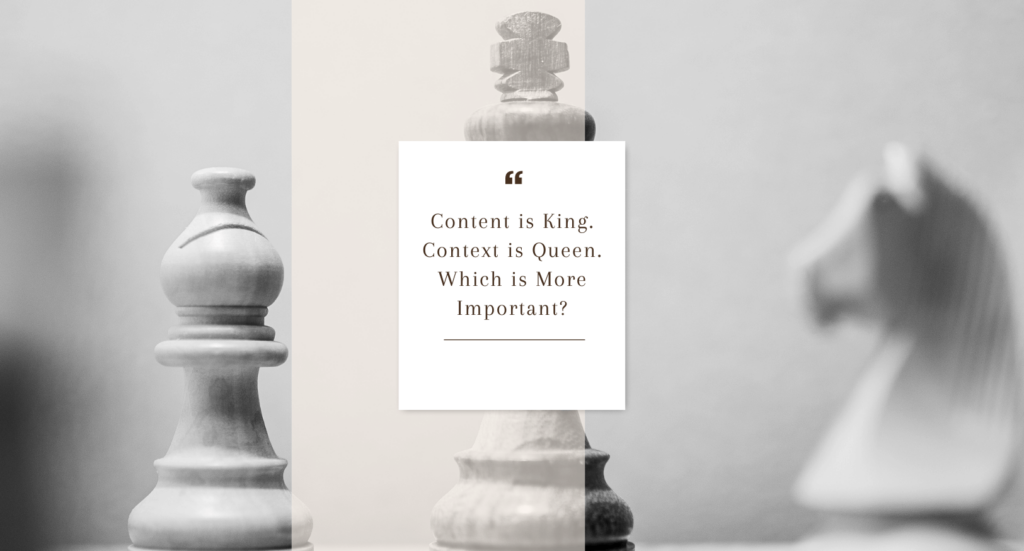Content is King. Context is Queen. Which is More Important?
December 25, 2023

You might be sick of hearing this. But I gotta say it. Okay, deep breath. Content is king. But in chess, it’s the queen who holds power. And when you’re coming up with a digital marketing plan, crafting content sure feels like a chess game. So, which is more important? Content or context? The thing is, content and context should both hold court.
A Lonely King is Meaningless
Content for the sake of content, just putting stuff out there and hoping it will hit the right note with your target customer, is meaningless. I might add it’s a total waste of your time and marketing budget.
For your content to do its job and royally well, you need a distribution plan.
Ha! You thought I was gonna say context. Hang tight. That’s coming up soon.
The Bridge Between Content and Context
The way you distribute your content is how you ensure it gets seen. You have an audience that religiously checks your blog — another who loves to interact with you on social media. And still, another checks their inbox for your messages. A distribution plan is how you make sure your content gets to all these places, although the list isn’t exhaustive.
Okay, so distribution plans are beyond the scope of this post. But let’s break down how distribution is the bridge holding your content and context together.
Without adequate distribution, your content goes nowhere. It won’t be seen by the right people. If your content gets in front of the right people, the context is what gives it meaning.
Context is what makes your distribution strategy effective. And so, what separates good content from the bad? Context. They all pretty much work together to make your digital marketing a success — content, context, and distribution.
So, what exactly do content and context mean?
How do you win a game of chess? You have to keep your king alive. And using the queen is one of the best ways to do so. In the game of content marketing, context is the queen that makes your king content an even bigger success.
Content is simply branded materials you share with your audience. That can be blogs, videos, social media posts, brochures, etc.
Context is the secret sauce that makes your content meaningful. It’s the circumstances surrounding when, how, or why a person sees your content and goes eureka!
Here are some examples of context in content marketing:
- •The time a person sees the content
- •What the viewer’s demographic background is
- •If the viewer is familiar or not with your brand
Context can be nuanced or granular. Seasonality, cultural traditions, and current events can all impact the context of a piece of content. For example, the Covid-19 pandemic gave new context to many brand’s marketing campaigns.
Context marketing definition
In a nutshell, context marketing is getting your message in front of the right person at precisely the right time, when they’re most receptive to hearing it.
The Royal Wedding of Content and Context
Is your content falling flat? It could be that it lacks context. Here are some steps to take to make sure your content has the context it needs to really sing with your target audience.
- Buyer personas — Your content won’t have the right level of context to convert if you don’t know who you’re talking to. Nail down your buyer personas. Give them a name, an age, a job title. Know who they are so you can speak directly to their wants and fears.
- Pain points — Okay, now that you know the people you’re trying to reach because you’ve nailed down your buyer personas, figure out their pain points. When you know what problems they need solved, you can give your content the context it needs to resonate with the people you’re trying to help.
- Make the content supportive — Give your audience content that is supportive and helps them overcome their obstacles. Use testimonials to build trust. Case studies to explain how you can help, and informative articles and explainer videos to further support your customers.
- Dynamic features — Impersonal content frustrates your buyers. Use all the tools at your disposal. CRM software and your marketing automation tools will have the features you need to send personalized content to the right people at the right time. Use merge tags and the data you have to give your content the personalized context it needs to convert.
Content and Context: Key Takeaways
Context is a powerful thing. Have you ever said the wrong thing to someone? In your head, it sounded good. But it went over like a lead balloon, and now they’re offended or think you’re a dummy. Hey, don’t feel bad. It happens to all of us.
Content isn’t more important than context. You should stay away from churning out content just for the sake of it.
Give your content the context it deserves. Get it in front of the right person, and you’ll be saying the right thing at the right time. Content empowered with context will increase your conversions, build your audience, and their trust in your brand.
Boost Your Content Game with Be-Creatives.com
Looking for easy and affordable solutions to up your content creation? Find it at Be-Creatives.com! Our shop is packed with easy-to-use, stunning templates for all your content needs, no matter your niche. Make your posts pop and your projects shine with just a few clicks. Ready to stand out?